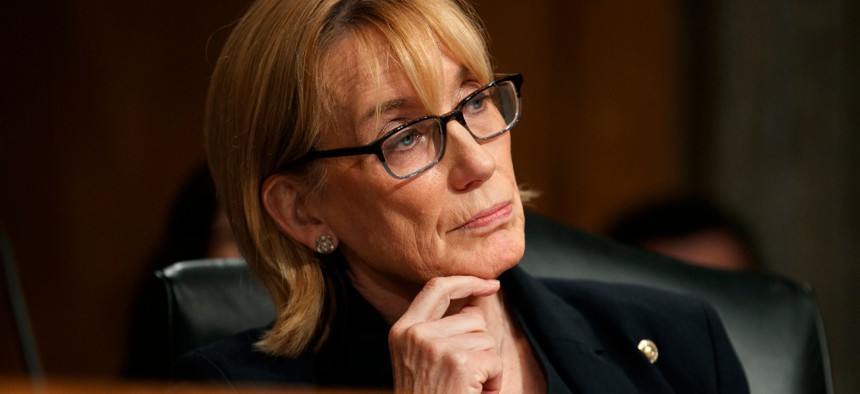Lawmaker Wants Hard Details on Agencies’ Plans to Upgrade Legacy IT

Sen. Maggie Hassan Jacquelyn Martin/AP
Sen. Maggie Hassan gave 10 agencies until August 3 to answer six questions about their modernization plans—or lack thereof.
While legacy IT issues have plagued federal agencies for years, the current COVID-19 crisis has exacerbated those issues and at least one lawmaker wants to know what agencies are doing about it.
On Wednesday, Sen. Maggie Hassan, D-N.H., sent letters to 10 major federal agencies—including the departments of Treasury, Homeland Security, Defense, Interior, Education, Health and Human Services, Transportation, the Office of Personnel Management, the Small Business Administration and the Social Security Administration—asking what each is doing to modernize aging IT systems in time for the next crisis.
In the letters, Hassan pointed out that, in fiscal 2019, the federal government spent nearly one-third of the $87 billion allocated for IT—or $29 billion—on maintaining legacy systems, based on figures submitted to the Office of Management and Budget using the Technology Business Management framework.
“I write to urge you to work together to modernize the [department’s] information technology systems in order to improve security, increase efficiency, and reduce wasteful spending associated with the maintenance of legacy IT systems,” she wrote in the letters. “As the amounts spent to operate and maintain existing systems increase each year, government-wide investment in major IT projects is declining.”
Hassan noted that Congress and the executive branch have been focused on legacy IT issues for time, including passage of the Federal IT Acquisition Reform Act, or FITARA, in 2014 and the addition of IT acquisition management to the Government Accountability Office’s High Risk List in 2015.
Despite these efforts, “agencies continue to rely on aging legacy systems for some of their most critical operations,” she wrote.
For each agency, Hassan included an example of a legacy system that is draining resources and in need of modernization. For instance, the letter sent to Treasury CFO Carole Banks and CIO Eric Olsen cites the 51-year-old, COBOL-programed system used by the IRS to process tax returns. The system costs the department $5.5 million a year to operate and another $10.4 million in annual labor costs to support.
“The department estimates it would cost $1.6 billion to modernize, but the benefits of modernization may balance those costs,” Hassan wrote. “Modernizing this system will no doubt increase agency response to customers and garner greater efficiencies, especially in times where immediate action is required to deliver on congressional mandates in a time of crisis.”
While these issues are not new, Hassan said the current COVID-19 pandemic—including supporting mass telework for the majority of federal employees—“underscores” the problem. That was the case with the IRS system, which was used to disburse economic relief payments.
“IRS relied on this system to distribute those payments. However, that required specialists to recode the COBOL program,” she said.
Each letter concluded with the same six questions:
- Does your agency have a comprehensive IT modernization plan?
- If so, please attach it to your response.
- If not, please provide a comprehensive IT modernization plan for your agency.
- What are the top five modernization priorities for your agency? For each, please provide or describe:
- the modernization plan for the priority;
- the expected cost of modernization and any anticipated cost-savings as a result of modernization;
- the expected completion date of the modernization; and
- the reason(s) for any schedule delays or cost overruns to date.
- What is the status of the modernization of the legacy system identified by GAO and described in this letter?
- Please describe your efforts to phase out the use of legacy systems that are physically outdated and do not support current software capabilities, are no longer supported by the vendor or manufacturer, or require specialized employees or contractors to operate and maintain. For example, have you conducted a survey of your IT systems based on use and determined which systems can be eliminated to reduce waste?
- Please describe the coordination between the Office of the Chief Information Officer and the Office of the Chief Financial Officer on IT acquisitions.
- In particular, how has the implementation of FITARA changed the way your agency acquires, maintains, and organizes its IT investments?
- How can your offices' coordination under FITARA be improved to better address IT modernization across the agency, especially for legacy systems?
- Finally, how can Congress better facilitate or oversee the modernization of government IT systems to achieve greater system reliability, security, and fiscal efficiency?
The letter asks that each agency respond in full by August 3.






